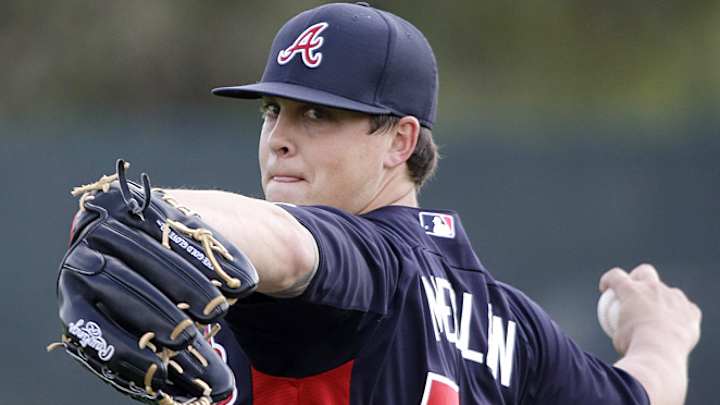Burning Questions: Is Kris Medlen a top-tier fantasy starter?


Fantasy baseball 2013 draft prep central: Rankings, position primers and much more
How does a guy who made just 12 starts last season emerge as a Cy Young candidate? Going 10-1 with a 1.57 ERA is a good start. Delivered a four-start run in which you allow zero runs in 33 innings while surrendering just 22 hits and striking out 34 helps, too.
Kris Medlen, who started the year in the bullpen after returning from Tommy John surgery, didn't make his first start of the 2012 season until July 31. But the numbers mentioned above have propelled the Braves' starter into the discussion about the best pitchers in baseball. While Medlen has been a darling of the sabermetric community, with this writer among his greatest admirers, all we've really seen from him are two wildly successful half-seasons, with a devastating elbow injury in between. As we'll see soon, some of his advanced stats from last year suggest Medlen had plenty of good fortune to go with his skills.
In trying to assess whether or not Medlen is for real, let's take a look at his prospects for 2013.
PRINTABLE DRAFT KIT: Top 300 Cheat Sheet | Position Rankings Cheat Sheet
Medlen was undeniably one of the best starting pitchers in baseball last year, even though he was only in Atlanta's rotation for the last two months of the season. In addition to all the stats listed above, he fanned 120 batters while walking just 23 in 138 innings. He had a 2.42 FIP and 0.91 WHIP. He dominated down the stretch and helped the Braves run away with the top wild-card spot. We're not debating whether or not he's a guy you'd want on your team. Rather, we're trying to forecast where he belongs among his peers. Is he a top-15 pitcher? Top-20? Or is he more appropriately slotted in the mid-20s? The answer lies within an examination of his peripherals.
Medlen is a three-pitch pitcher. He doesn't blow anyone away with his low-90s heat, but his true out pitches are his curveball and changeup. Medlen didn't throw enough innings to qualify for Fangraphs pitch values rankings, but his 16.6 changeup value gave him the second-best changeup in baseball last year (behind Jason Vargas), ahead of noted changeup artists such as Cole Hamels and Chris Sale. Medlen's curveball registered an 8.7, good for sixth overall and better than David Price, Felix Hernandez and Mat Latos. The only pitchers with a better curveball than Medlen? Adam Wainwright, A.J. Burnett, Justin Verlander, Clayton Kershaw and Gio Gonzalez. That's pretty good company. As someone in the market for starting pitching, I love this about Medlen. The fact that he has two out pitches that are both off-speed gives me a ton of confidence. This is not a guy who is totally dependent on a powerful arm to get outs. And with hitters necessarily looking for his off-speed stuff, his 90-mph fastball gets on them a whole lot quicker.
Given that Medlen features one of the game's premier changeups, this next stat will come as no surprise: He got nearly two ground balls for every fly ball last year. Medlen's ground-ball rate was 53.4 percent, compared with a fly-ball rate of 28.2 percent. That goes a long way toward explaining his .261 BABIP. In most cases, that would be a case of extreme good luck that would be awfully hard to replicate. But when you're getting ground balls 53 percent of the time and have Andrelton Simmons and Martin Prado in your infield, it makes a lot more sense. Now, the chances of Medlen posting a .261 BABIP again are slim. But entering this season, we have no reason to believe achieving a below-average BABIP is not a skill of his.
Medlen was, however, quite lucky when it came to leaving runners on base. He had a strand rate of 85 percent, fully 10 percentage points higher than the league average. Strikeout pitchers like Medlen tend to have better strand rates, simply by limiting the amount of seeing-eye singles or bloopers that find a patch of grass, or even RBI groundouts. Still, leaving 85 percent of your runners on base is nearly impossible to duplicate. It's possible across a half-season sample, but that likely would have normalized last year had Medlen been in the rotation all season. Expect some regression there, which will ultimately show up in Medlen's ERA.
Taking all of this into account, it becomes a bit clearer why forecasting Medlen's 2013 prospects is such a challenge. He had one good stretch, and another dominant one, the two times he has been in Atlanta's rotation. His stuff grades out to a level where we should be plenty confident in him maintaining that success over a full season. But the fact that we've yet to see it, and that he had luck on his side last year, clouds his forecast.
Ultimately, I'm a believer. His stuff is undeniable, he's on one of the best teams in the majors, he gets strikeouts at a high rate, he keeps the ball on the ground and he's entering his age-27 season. Medlen is the 18th pitcher on my board, just behind Gio Gonzalez and CC Sabathia and just ahead of Chris Sale, Johnny Cueto, Jordan Zimmermann and Yovani Gallardo.
More Burning Questions: ? Part I: Can Trout, Harper avoid sophomore slump? ? Part II: Will R.A. Dickey regress after Cy Young? ? Part III: Is Anthony Rizzo an elite first baseman? ? Part IV: Can Brett Lawrie reach his potential? ? Part V: How will the Upton brothers fare in Atlanta? ? Part VI: Is Atlanta's Kris Medlen a top-tier starter? ? Part VII: Is Kansas City's Eric Hosmer worth the wait? ? Part VIII: Can Wil Myers be MLB's next rookie sensation? ? Part IX: Are hitters still more valuable than pitchers? ? Part X: Predictions for the 2013 MLB season
